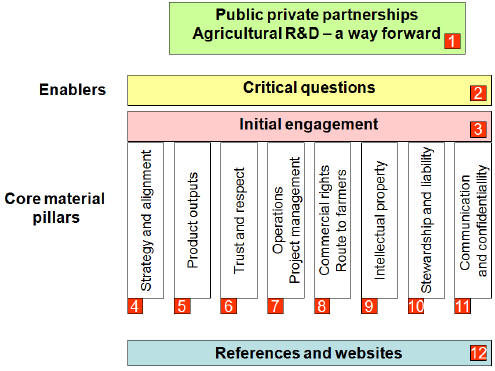Introduction: Creating a way forward
The Syngenta Foundation for Sustainable Agriculture (SFSA) believes that it is essential to overcome the historical separation of public and private sector research. Over the next two decades, innovative approaches are urgently needed to address food security issues for resource-poor farmers in developing countries.
Public-private partnerships (PPPs) have the potential to accelerate the delivery of outputs from agricultural research and development. PPPs currently underway must deliver their goals. SFSA also wishes to encourage new PPPs that can create unique outcomes unachievable by individual parties alone.
Partnerships have become more important than ever in recent years. The pressure on agriculture to produce enough food, sustainably, for a growing world population continues to increase. However, in many countries government spending on public agricultural R&D has fallen, and some of the skills needed reside predominantly in the private sector.
The process of developing, negotiating, and establishing viable partnerships is not easy. Sometimes, alignment difficulties prevent them getting off the ground at all. Some partnerships seem to start well, but then never deliver their true potential in spite of major financial, intellectual, and emotional investment by the parties involved. Negotiations can often become lengthy and costly.
If the PPP’s benefits are attractive enough, then parties usually find creative ways to overcome “material blockers” – but these can waste a lot of time and money on the way. Individual strategies and approaches, institutional core values, history, stakeholder positions, personalities and operational differences can all cause problems.

(Each number refers to a separate web section containing options for best practice).
A range of major public-private partnerships have been initiated on major food crops in recent years1 . A wealth of understanding about partner relationship development and delivery of aspirational goals is available in institutions. This is primarily experience-based, from involvement in partnerships, rather than learned through formal training.
Ferroni, M. (2010) Can Private Sector R&D Reach Small Farmers? Proceedings of 2009 Annual Conference ATSE, Crawford Fund pp1-10
Purpose and use
Self-help tool. This guidance framework is intended primarily as a source of advice to the public sector. (In a parallel section of this website public sector partners of the SFSA provide their own special insights).
The guidance framework is a self-help tool for practitioners in agricultural R&D and their supporting professional advisors (researchers, managers, licensing, stewardship, business, and legal/intellectual property professionals). The main focus is currently on research, rather than development.
The chapters here provide a broad base of experience from both the public and private sectors. Each partnership will, however, have an individual identity, and this guidance framework cannot cover all possible cases. SFSA does not intend the document to be prescriptive, but an aid to creating innovative and sustainable solutions.
Focus: plant varieties, technologies and services. The guidance framework focuses primarily on PPPs aimed at improving performance and utility of varieties grown by subsistence farmers, e.g. in the areas of native traits, germplasm, traditional breeding, agricultural biotechnology, crop protection technology, and farmer services.
Deal-breakers. The guidance framework focuses on core issues that have historically proved to be “deal-breakers” or become problematic during PPPs, and provides ideas on best practice and options for problem-solving.
Contents
This guidance framework contains a series of stand-alone topics. They can be viewed individually or together to explore best practice on creating and making PPPs work. Each topic is fundamental and can make or break the formation of a partnership, or is material to the delivery of successful product outcomes. Access to each topic is via the box in our right-hand column.
Contributors, acknowledgements and disclaimer
This guidance framework distils experience and knowledge from SFSA staff, consultants, network partners and workshop participants. Representatives attended from CGIAR centers, international agribusinesses, seed companies, and major donors.
SFSA would particularly like to acknowledge the assistance of Dr. Vivienne Anthony in the preparation of this guidance framework.
SFSA disclaims all responsibility for any negative or unwanted results of any decisions taken directly or indirectly on the basis of this guidance framework, as well as for any financial and resource implications of such decisions. SFSA also expressly emphasizes that the guidance contained here represents the Foundation’s current thinking on this topic, which is subject to evolution. The views expressed in the parallel section of interviews with public partners do not necessarily reflect those of SFSA.
